Individual Report: Foundations of Business Communication
VerifiedAdded on 2022/12/29
|15
|4766
|83
Report
AI Summary
This report is divided into two parts. Part 1 delves into sustainable business strategies and management, examining how companies like Tesco, ASDA, and Sainsbury integrate environmental, economic, and social goals. It explores different approaches to Corporate Social Responsibility (CSR) across corporate, micro, and SME businesses, analyzing their similarities and differences, and how they measure success. Part 2 presents a reflective report on key skills developed throughout the unit. The report highlights the importance of sustainable practices, ethical considerations, and the impact of CSR on business operations and stakeholder relations. The analysis covers various aspects of sustainable business practices, including packaging, carbon footprint reduction, and waste management, providing a comprehensive overview of the subject.
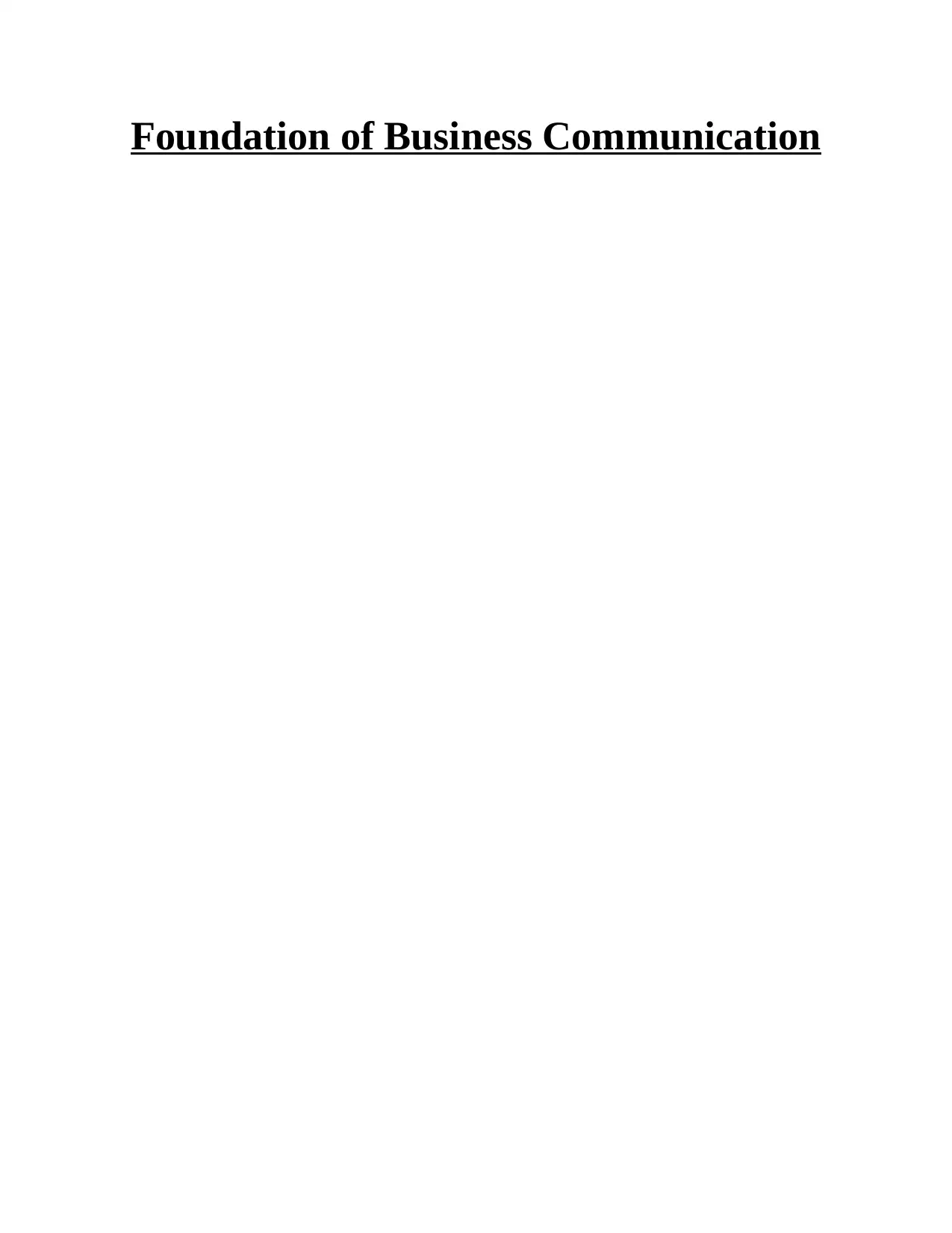
Foundation of Business Communication
Paraphrase This Document
Need a fresh take? Get an instant paraphrase of this document with our AI Paraphraser
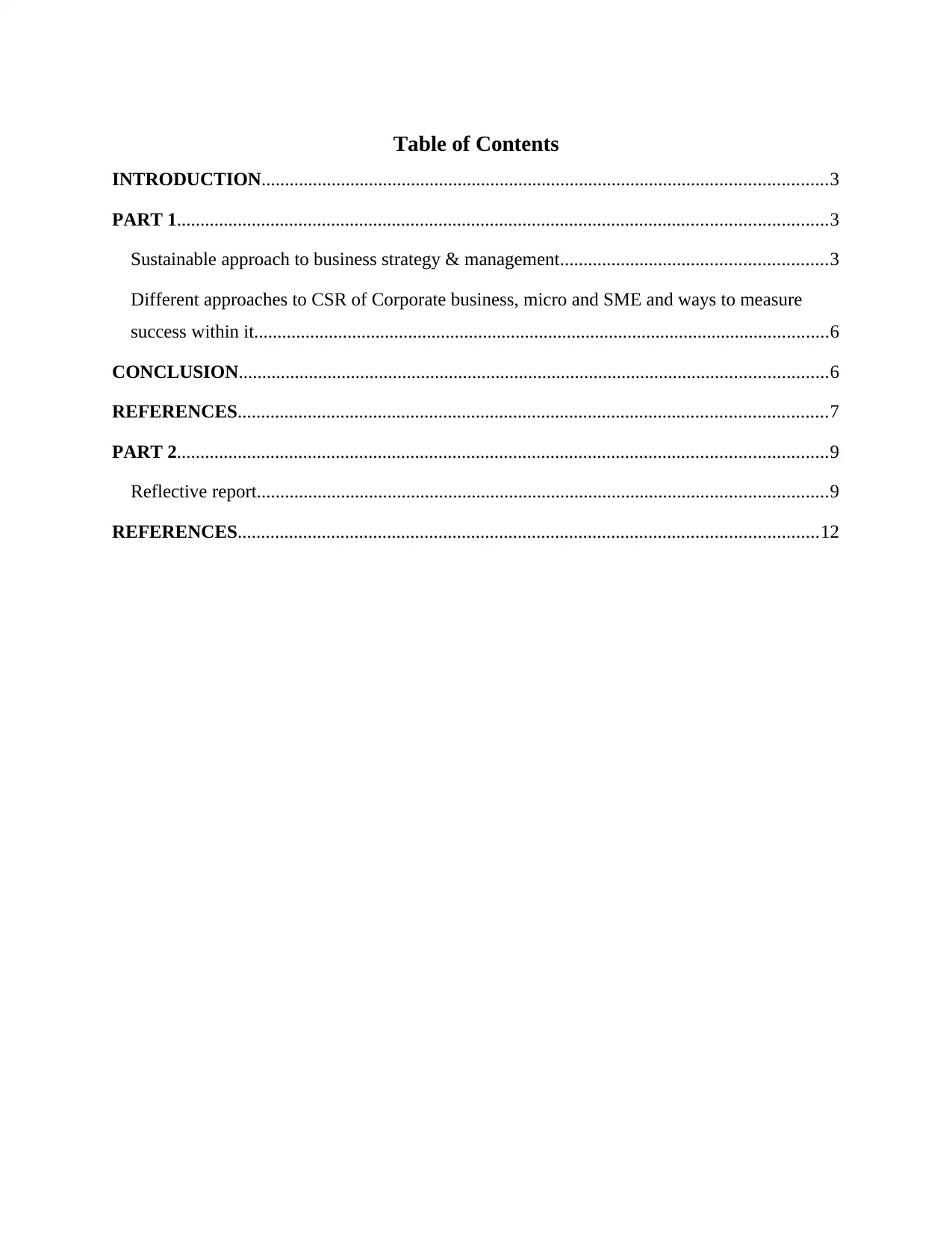
Table of Contents
INTRODUCTION.........................................................................................................................3
PART 1...........................................................................................................................................3
Sustainable approach to business strategy & management.........................................................3
Different approaches to CSR of Corporate business, micro and SME and ways to measure
success within it...........................................................................................................................6
CONCLUSION..............................................................................................................................6
REFERENCES..............................................................................................................................7
PART 2...........................................................................................................................................9
Reflective report..........................................................................................................................9
REFERENCES............................................................................................................................12
INTRODUCTION.........................................................................................................................3
PART 1...........................................................................................................................................3
Sustainable approach to business strategy & management.........................................................3
Different approaches to CSR of Corporate business, micro and SME and ways to measure
success within it...........................................................................................................................6
CONCLUSION..............................................................................................................................6
REFERENCES..............................................................................................................................7
PART 2...........................................................................................................................................9
Reflective report..........................................................................................................................9
REFERENCES............................................................................................................................12
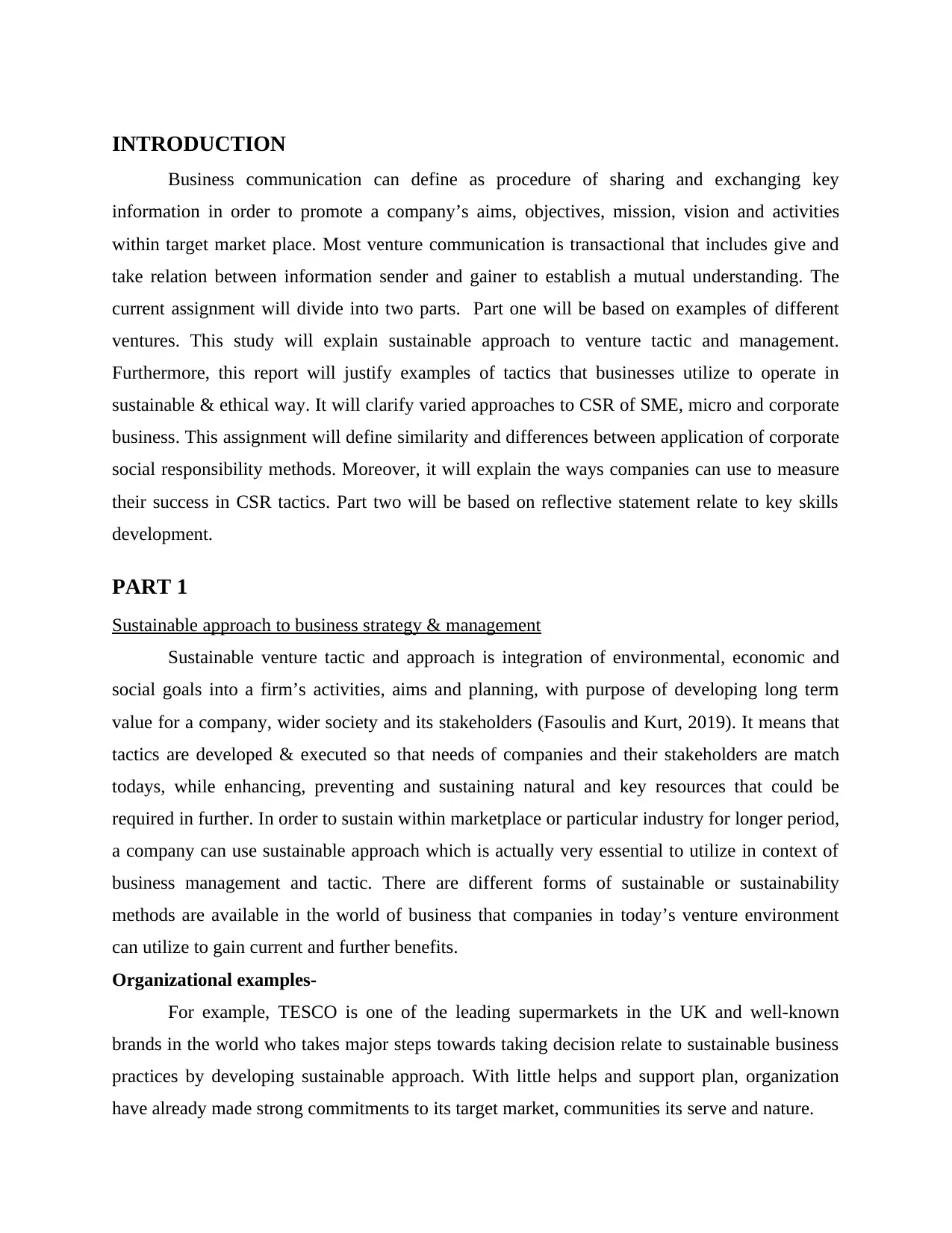
INTRODUCTION
Business communication can define as procedure of sharing and exchanging key
information in order to promote a company’s aims, objectives, mission, vision and activities
within target market place. Most venture communication is transactional that includes give and
take relation between information sender and gainer to establish a mutual understanding. The
current assignment will divide into two parts. Part one will be based on examples of different
ventures. This study will explain sustainable approach to venture tactic and management.
Furthermore, this report will justify examples of tactics that businesses utilize to operate in
sustainable & ethical way. It will clarify varied approaches to CSR of SME, micro and corporate
business. This assignment will define similarity and differences between application of corporate
social responsibility methods. Moreover, it will explain the ways companies can use to measure
their success in CSR tactics. Part two will be based on reflective statement relate to key skills
development.
PART 1
Sustainable approach to business strategy & management
Sustainable venture tactic and approach is integration of environmental, economic and
social goals into a firm’s activities, aims and planning, with purpose of developing long term
value for a company, wider society and its stakeholders (Fasoulis and Kurt, 2019). It means that
tactics are developed & executed so that needs of companies and their stakeholders are match
todays, while enhancing, preventing and sustaining natural and key resources that could be
required in further. In order to sustain within marketplace or particular industry for longer period,
a company can use sustainable approach which is actually very essential to utilize in context of
business management and tactic. There are different forms of sustainable or sustainability
methods are available in the world of business that companies in today’s venture environment
can utilize to gain current and further benefits.
Organizational examples-
For example, TESCO is one of the leading supermarkets in the UK and well-known
brands in the world who takes major steps towards taking decision relate to sustainable business
practices by developing sustainable approach. With little helps and support plan, organization
have already made strong commitments to its target market, communities its serve and nature.
Business communication can define as procedure of sharing and exchanging key
information in order to promote a company’s aims, objectives, mission, vision and activities
within target market place. Most venture communication is transactional that includes give and
take relation between information sender and gainer to establish a mutual understanding. The
current assignment will divide into two parts. Part one will be based on examples of different
ventures. This study will explain sustainable approach to venture tactic and management.
Furthermore, this report will justify examples of tactics that businesses utilize to operate in
sustainable & ethical way. It will clarify varied approaches to CSR of SME, micro and corporate
business. This assignment will define similarity and differences between application of corporate
social responsibility methods. Moreover, it will explain the ways companies can use to measure
their success in CSR tactics. Part two will be based on reflective statement relate to key skills
development.
PART 1
Sustainable approach to business strategy & management
Sustainable venture tactic and approach is integration of environmental, economic and
social goals into a firm’s activities, aims and planning, with purpose of developing long term
value for a company, wider society and its stakeholders (Fasoulis and Kurt, 2019). It means that
tactics are developed & executed so that needs of companies and their stakeholders are match
todays, while enhancing, preventing and sustaining natural and key resources that could be
required in further. In order to sustain within marketplace or particular industry for longer period,
a company can use sustainable approach which is actually very essential to utilize in context of
business management and tactic. There are different forms of sustainable or sustainability
methods are available in the world of business that companies in today’s venture environment
can utilize to gain current and further benefits.
Organizational examples-
For example, TESCO is one of the leading supermarkets in the UK and well-known
brands in the world who takes major steps towards taking decision relate to sustainable business
practices by developing sustainable approach. With little helps and support plan, organization
have already made strong commitments to its target market, communities its serve and nature.
⊘ This is a preview!⊘
Do you want full access?
Subscribe today to unlock all pages.

Trusted by 1+ million students worldwide
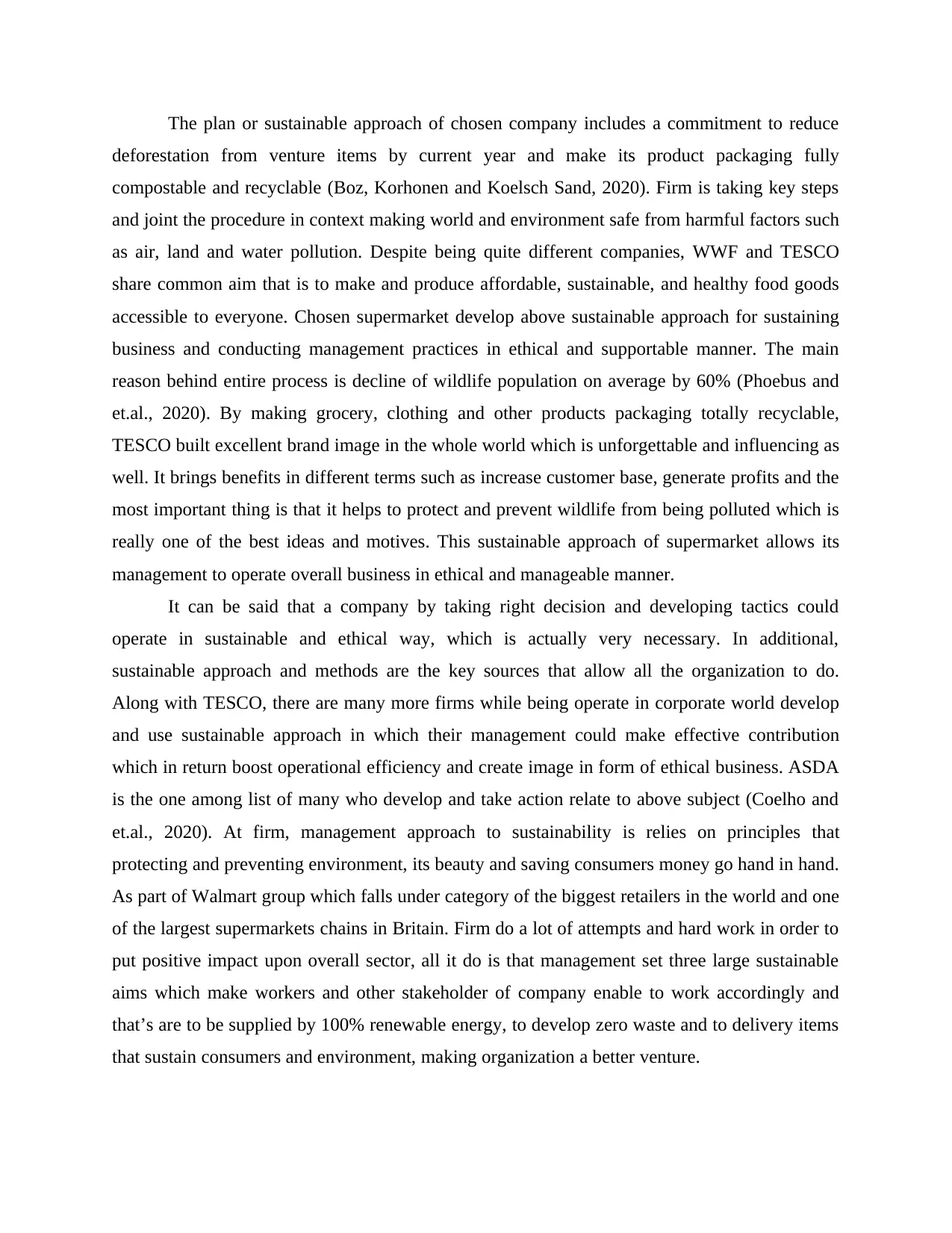
The plan or sustainable approach of chosen company includes a commitment to reduce
deforestation from venture items by current year and make its product packaging fully
compostable and recyclable (Boz, Korhonen and Koelsch Sand, 2020). Firm is taking key steps
and joint the procedure in context making world and environment safe from harmful factors such
as air, land and water pollution. Despite being quite different companies, WWF and TESCO
share common aim that is to make and produce affordable, sustainable, and healthy food goods
accessible to everyone. Chosen supermarket develop above sustainable approach for sustaining
business and conducting management practices in ethical and supportable manner. The main
reason behind entire process is decline of wildlife population on average by 60% (Phoebus and
et.al., 2020). By making grocery, clothing and other products packaging totally recyclable,
TESCO built excellent brand image in the whole world which is unforgettable and influencing as
well. It brings benefits in different terms such as increase customer base, generate profits and the
most important thing is that it helps to protect and prevent wildlife from being polluted which is
really one of the best ideas and motives. This sustainable approach of supermarket allows its
management to operate overall business in ethical and manageable manner.
It can be said that a company by taking right decision and developing tactics could
operate in sustainable and ethical way, which is actually very necessary. In additional,
sustainable approach and methods are the key sources that allow all the organization to do.
Along with TESCO, there are many more firms while being operate in corporate world develop
and use sustainable approach in which their management could make effective contribution
which in return boost operational efficiency and create image in form of ethical business. ASDA
is the one among list of many who develop and take action relate to above subject (Coelho and
et.al., 2020). At firm, management approach to sustainability is relies on principles that
protecting and preventing environment, its beauty and saving consumers money go hand in hand.
As part of Walmart group which falls under category of the biggest retailers in the world and one
of the largest supermarkets chains in Britain. Firm do a lot of attempts and hard work in order to
put positive impact upon overall sector, all it do is that management set three large sustainable
aims which make workers and other stakeholder of company enable to work accordingly and
that’s are to be supplied by 100% renewable energy, to develop zero waste and to delivery items
that sustain consumers and environment, making organization a better venture.
deforestation from venture items by current year and make its product packaging fully
compostable and recyclable (Boz, Korhonen and Koelsch Sand, 2020). Firm is taking key steps
and joint the procedure in context making world and environment safe from harmful factors such
as air, land and water pollution. Despite being quite different companies, WWF and TESCO
share common aim that is to make and produce affordable, sustainable, and healthy food goods
accessible to everyone. Chosen supermarket develop above sustainable approach for sustaining
business and conducting management practices in ethical and supportable manner. The main
reason behind entire process is decline of wildlife population on average by 60% (Phoebus and
et.al., 2020). By making grocery, clothing and other products packaging totally recyclable,
TESCO built excellent brand image in the whole world which is unforgettable and influencing as
well. It brings benefits in different terms such as increase customer base, generate profits and the
most important thing is that it helps to protect and prevent wildlife from being polluted which is
really one of the best ideas and motives. This sustainable approach of supermarket allows its
management to operate overall business in ethical and manageable manner.
It can be said that a company by taking right decision and developing tactics could
operate in sustainable and ethical way, which is actually very necessary. In additional,
sustainable approach and methods are the key sources that allow all the organization to do.
Along with TESCO, there are many more firms while being operate in corporate world develop
and use sustainable approach in which their management could make effective contribution
which in return boost operational efficiency and create image in form of ethical business. ASDA
is the one among list of many who develop and take action relate to above subject (Coelho and
et.al., 2020). At firm, management approach to sustainability is relies on principles that
protecting and preventing environment, its beauty and saving consumers money go hand in hand.
As part of Walmart group which falls under category of the biggest retailers in the world and one
of the largest supermarkets chains in Britain. Firm do a lot of attempts and hard work in order to
put positive impact upon overall sector, all it do is that management set three large sustainable
aims which make workers and other stakeholder of company enable to work accordingly and
that’s are to be supplied by 100% renewable energy, to develop zero waste and to delivery items
that sustain consumers and environment, making organization a better venture.
Paraphrase This Document
Need a fresh take? Get an instant paraphrase of this document with our AI Paraphraser
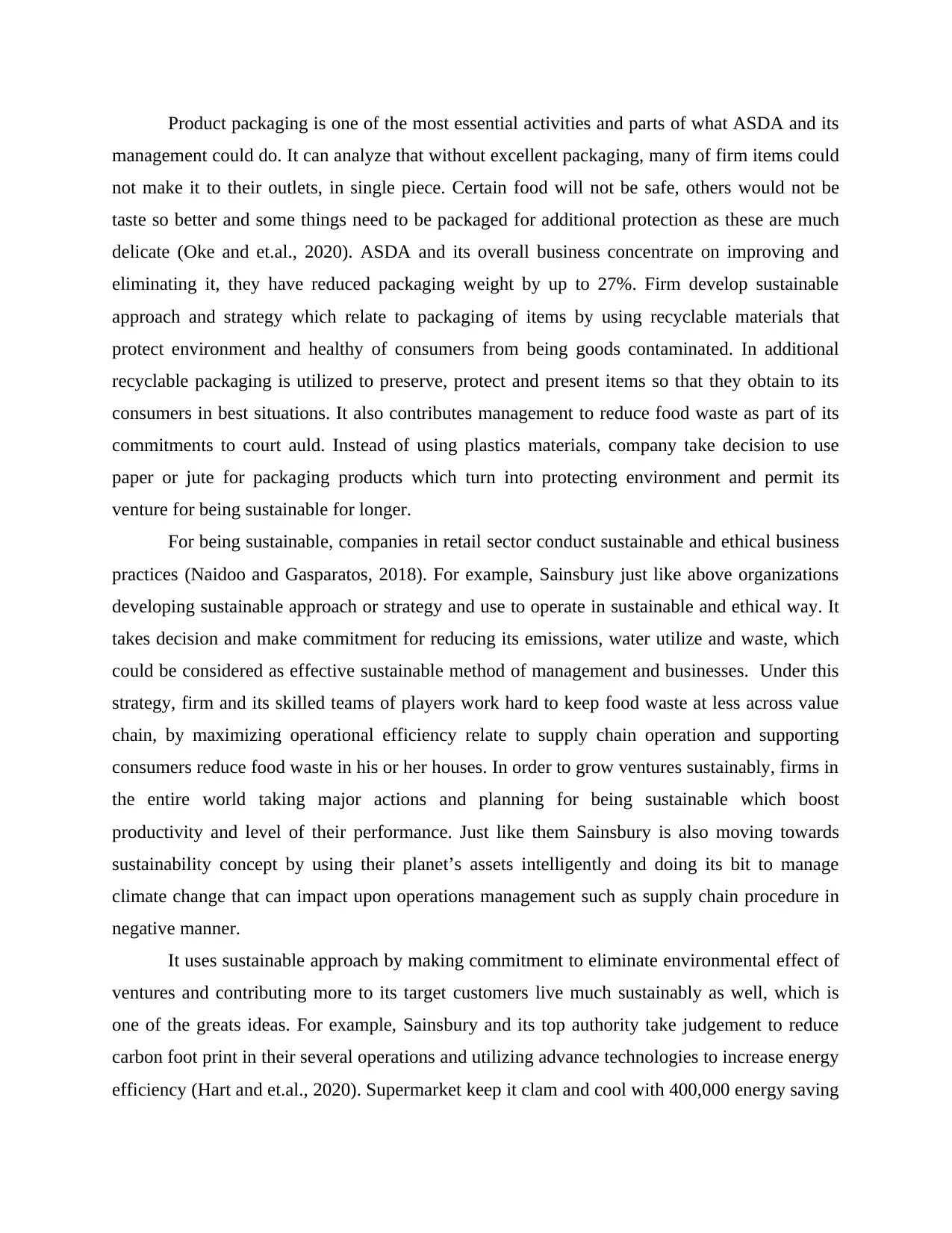
Product packaging is one of the most essential activities and parts of what ASDA and its
management could do. It can analyze that without excellent packaging, many of firm items could
not make it to their outlets, in single piece. Certain food will not be safe, others would not be
taste so better and some things need to be packaged for additional protection as these are much
delicate (Oke and et.al., 2020). ASDA and its overall business concentrate on improving and
eliminating it, they have reduced packaging weight by up to 27%. Firm develop sustainable
approach and strategy which relate to packaging of items by using recyclable materials that
protect environment and healthy of consumers from being goods contaminated. In additional
recyclable packaging is utilized to preserve, protect and present items so that they obtain to its
consumers in best situations. It also contributes management to reduce food waste as part of its
commitments to court auld. Instead of using plastics materials, company take decision to use
paper or jute for packaging products which turn into protecting environment and permit its
venture for being sustainable for longer.
For being sustainable, companies in retail sector conduct sustainable and ethical business
practices (Naidoo and Gasparatos, 2018). For example, Sainsbury just like above organizations
developing sustainable approach or strategy and use to operate in sustainable and ethical way. It
takes decision and make commitment for reducing its emissions, water utilize and waste, which
could be considered as effective sustainable method of management and businesses. Under this
strategy, firm and its skilled teams of players work hard to keep food waste at less across value
chain, by maximizing operational efficiency relate to supply chain operation and supporting
consumers reduce food waste in his or her houses. In order to grow ventures sustainably, firms in
the entire world taking major actions and planning for being sustainable which boost
productivity and level of their performance. Just like them Sainsbury is also moving towards
sustainability concept by using their planet’s assets intelligently and doing its bit to manage
climate change that can impact upon operations management such as supply chain procedure in
negative manner.
It uses sustainable approach by making commitment to eliminate environmental effect of
ventures and contributing more to its target customers live much sustainably as well, which is
one of the greats ideas. For example, Sainsbury and its top authority take judgement to reduce
carbon foot print in their several operations and utilizing advance technologies to increase energy
efficiency (Hart and et.al., 2020). Supermarket keep it clam and cool with 400,000 energy saving
management could do. It can analyze that without excellent packaging, many of firm items could
not make it to their outlets, in single piece. Certain food will not be safe, others would not be
taste so better and some things need to be packaged for additional protection as these are much
delicate (Oke and et.al., 2020). ASDA and its overall business concentrate on improving and
eliminating it, they have reduced packaging weight by up to 27%. Firm develop sustainable
approach and strategy which relate to packaging of items by using recyclable materials that
protect environment and healthy of consumers from being goods contaminated. In additional
recyclable packaging is utilized to preserve, protect and present items so that they obtain to its
consumers in best situations. It also contributes management to reduce food waste as part of its
commitments to court auld. Instead of using plastics materials, company take decision to use
paper or jute for packaging products which turn into protecting environment and permit its
venture for being sustainable for longer.
For being sustainable, companies in retail sector conduct sustainable and ethical business
practices (Naidoo and Gasparatos, 2018). For example, Sainsbury just like above organizations
developing sustainable approach or strategy and use to operate in sustainable and ethical way. It
takes decision and make commitment for reducing its emissions, water utilize and waste, which
could be considered as effective sustainable method of management and businesses. Under this
strategy, firm and its skilled teams of players work hard to keep food waste at less across value
chain, by maximizing operational efficiency relate to supply chain operation and supporting
consumers reduce food waste in his or her houses. In order to grow ventures sustainably, firms in
the entire world taking major actions and planning for being sustainable which boost
productivity and level of their performance. Just like them Sainsbury is also moving towards
sustainability concept by using their planet’s assets intelligently and doing its bit to manage
climate change that can impact upon operations management such as supply chain procedure in
negative manner.
It uses sustainable approach by making commitment to eliminate environmental effect of
ventures and contributing more to its target customers live much sustainably as well, which is
one of the greats ideas. For example, Sainsbury and its top authority take judgement to reduce
carbon foot print in their several operations and utilizing advance technologies to increase energy
efficiency (Hart and et.al., 2020). Supermarket keep it clam and cool with 400,000 energy saving
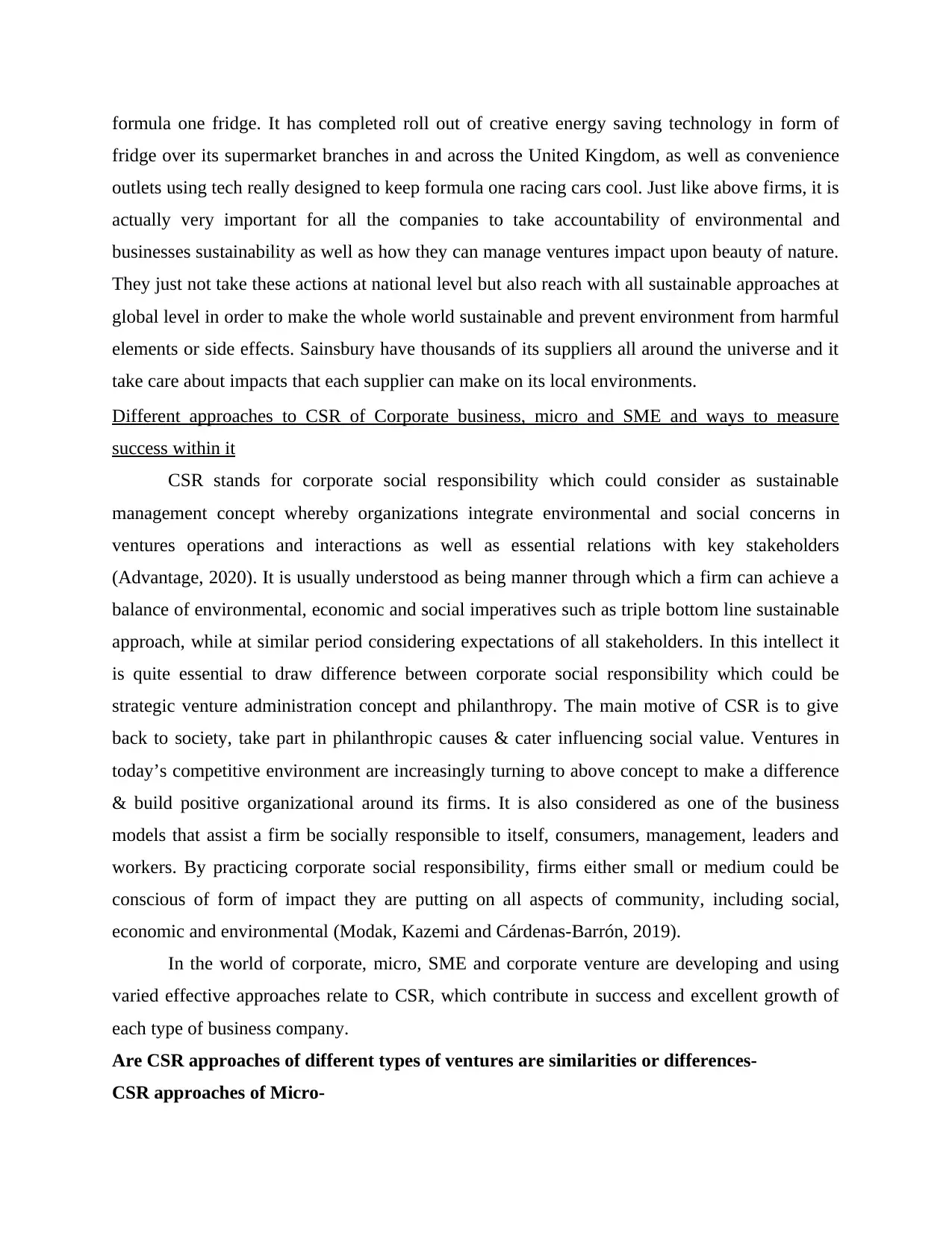
formula one fridge. It has completed roll out of creative energy saving technology in form of
fridge over its supermarket branches in and across the United Kingdom, as well as convenience
outlets using tech really designed to keep formula one racing cars cool. Just like above firms, it is
actually very important for all the companies to take accountability of environmental and
businesses sustainability as well as how they can manage ventures impact upon beauty of nature.
They just not take these actions at national level but also reach with all sustainable approaches at
global level in order to make the whole world sustainable and prevent environment from harmful
elements or side effects. Sainsbury have thousands of its suppliers all around the universe and it
take care about impacts that each supplier can make on its local environments.
Different approaches to CSR of Corporate business, micro and SME and ways to measure
success within it
CSR stands for corporate social responsibility which could consider as sustainable
management concept whereby organizations integrate environmental and social concerns in
ventures operations and interactions as well as essential relations with key stakeholders
(Advantage, 2020). It is usually understood as being manner through which a firm can achieve a
balance of environmental, economic and social imperatives such as triple bottom line sustainable
approach, while at similar period considering expectations of all stakeholders. In this intellect it
is quite essential to draw difference between corporate social responsibility which could be
strategic venture administration concept and philanthropy. The main motive of CSR is to give
back to society, take part in philanthropic causes & cater influencing social value. Ventures in
today’s competitive environment are increasingly turning to above concept to make a difference
& build positive organizational around its firms. It is also considered as one of the business
models that assist a firm be socially responsible to itself, consumers, management, leaders and
workers. By practicing corporate social responsibility, firms either small or medium could be
conscious of form of impact they are putting on all aspects of community, including social,
economic and environmental (Modak, Kazemi and Cárdenas-Barrón, 2019).
In the world of corporate, micro, SME and corporate venture are developing and using
varied effective approaches relate to CSR, which contribute in success and excellent growth of
each type of business company.
Are CSR approaches of different types of ventures are similarities or differences-
CSR approaches of Micro-
fridge over its supermarket branches in and across the United Kingdom, as well as convenience
outlets using tech really designed to keep formula one racing cars cool. Just like above firms, it is
actually very important for all the companies to take accountability of environmental and
businesses sustainability as well as how they can manage ventures impact upon beauty of nature.
They just not take these actions at national level but also reach with all sustainable approaches at
global level in order to make the whole world sustainable and prevent environment from harmful
elements or side effects. Sainsbury have thousands of its suppliers all around the universe and it
take care about impacts that each supplier can make on its local environments.
Different approaches to CSR of Corporate business, micro and SME and ways to measure
success within it
CSR stands for corporate social responsibility which could consider as sustainable
management concept whereby organizations integrate environmental and social concerns in
ventures operations and interactions as well as essential relations with key stakeholders
(Advantage, 2020). It is usually understood as being manner through which a firm can achieve a
balance of environmental, economic and social imperatives such as triple bottom line sustainable
approach, while at similar period considering expectations of all stakeholders. In this intellect it
is quite essential to draw difference between corporate social responsibility which could be
strategic venture administration concept and philanthropy. The main motive of CSR is to give
back to society, take part in philanthropic causes & cater influencing social value. Ventures in
today’s competitive environment are increasingly turning to above concept to make a difference
& build positive organizational around its firms. It is also considered as one of the business
models that assist a firm be socially responsible to itself, consumers, management, leaders and
workers. By practicing corporate social responsibility, firms either small or medium could be
conscious of form of impact they are putting on all aspects of community, including social,
economic and environmental (Modak, Kazemi and Cárdenas-Barrón, 2019).
In the world of corporate, micro, SME and corporate venture are developing and using
varied effective approaches relate to CSR, which contribute in success and excellent growth of
each type of business company.
Are CSR approaches of different types of ventures are similarities or differences-
CSR approaches of Micro-
⊘ This is a preview!⊘
Do you want full access?
Subscribe today to unlock all pages.

Trusted by 1+ million students worldwide
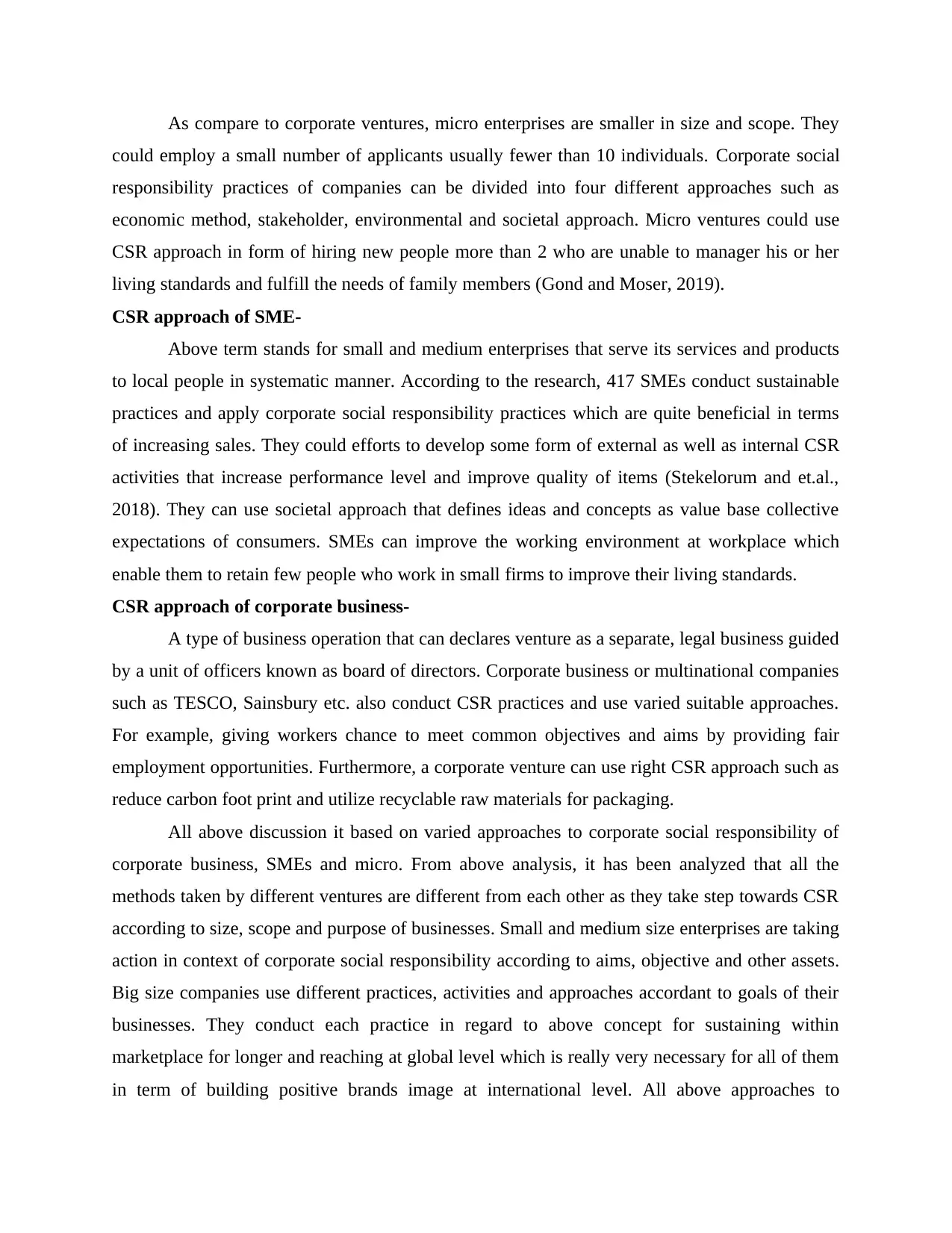
As compare to corporate ventures, micro enterprises are smaller in size and scope. They
could employ a small number of applicants usually fewer than 10 individuals. Corporate social
responsibility practices of companies can be divided into four different approaches such as
economic method, stakeholder, environmental and societal approach. Micro ventures could use
CSR approach in form of hiring new people more than 2 who are unable to manager his or her
living standards and fulfill the needs of family members (Gond and Moser, 2019).
CSR approach of SME-
Above term stands for small and medium enterprises that serve its services and products
to local people in systematic manner. According to the research, 417 SMEs conduct sustainable
practices and apply corporate social responsibility practices which are quite beneficial in terms
of increasing sales. They could efforts to develop some form of external as well as internal CSR
activities that increase performance level and improve quality of items (Stekelorum and et.al.,
2018). They can use societal approach that defines ideas and concepts as value base collective
expectations of consumers. SMEs can improve the working environment at workplace which
enable them to retain few people who work in small firms to improve their living standards.
CSR approach of corporate business-
A type of business operation that can declares venture as a separate, legal business guided
by a unit of officers known as board of directors. Corporate business or multinational companies
such as TESCO, Sainsbury etc. also conduct CSR practices and use varied suitable approaches.
For example, giving workers chance to meet common objectives and aims by providing fair
employment opportunities. Furthermore, a corporate venture can use right CSR approach such as
reduce carbon foot print and utilize recyclable raw materials for packaging.
All above discussion it based on varied approaches to corporate social responsibility of
corporate business, SMEs and micro. From above analysis, it has been analyzed that all the
methods taken by different ventures are different from each other as they take step towards CSR
according to size, scope and purpose of businesses. Small and medium size enterprises are taking
action in context of corporate social responsibility according to aims, objective and other assets.
Big size companies use different practices, activities and approaches accordant to goals of their
businesses. They conduct each practice in regard to above concept for sustaining within
marketplace for longer and reaching at global level which is really very necessary for all of them
in term of building positive brands image at international level. All above approaches to
could employ a small number of applicants usually fewer than 10 individuals. Corporate social
responsibility practices of companies can be divided into four different approaches such as
economic method, stakeholder, environmental and societal approach. Micro ventures could use
CSR approach in form of hiring new people more than 2 who are unable to manager his or her
living standards and fulfill the needs of family members (Gond and Moser, 2019).
CSR approach of SME-
Above term stands for small and medium enterprises that serve its services and products
to local people in systematic manner. According to the research, 417 SMEs conduct sustainable
practices and apply corporate social responsibility practices which are quite beneficial in terms
of increasing sales. They could efforts to develop some form of external as well as internal CSR
activities that increase performance level and improve quality of items (Stekelorum and et.al.,
2018). They can use societal approach that defines ideas and concepts as value base collective
expectations of consumers. SMEs can improve the working environment at workplace which
enable them to retain few people who work in small firms to improve their living standards.
CSR approach of corporate business-
A type of business operation that can declares venture as a separate, legal business guided
by a unit of officers known as board of directors. Corporate business or multinational companies
such as TESCO, Sainsbury etc. also conduct CSR practices and use varied suitable approaches.
For example, giving workers chance to meet common objectives and aims by providing fair
employment opportunities. Furthermore, a corporate venture can use right CSR approach such as
reduce carbon foot print and utilize recyclable raw materials for packaging.
All above discussion it based on varied approaches to corporate social responsibility of
corporate business, SMEs and micro. From above analysis, it has been analyzed that all the
methods taken by different ventures are different from each other as they take step towards CSR
according to size, scope and purpose of businesses. Small and medium size enterprises are taking
action in context of corporate social responsibility according to aims, objective and other assets.
Big size companies use different practices, activities and approaches accordant to goals of their
businesses. They conduct each practice in regard to above concept for sustaining within
marketplace for longer and reaching at global level which is really very necessary for all of them
in term of building positive brands image at international level. All above approaches to
Paraphrase This Document
Need a fresh take? Get an instant paraphrase of this document with our AI Paraphraser
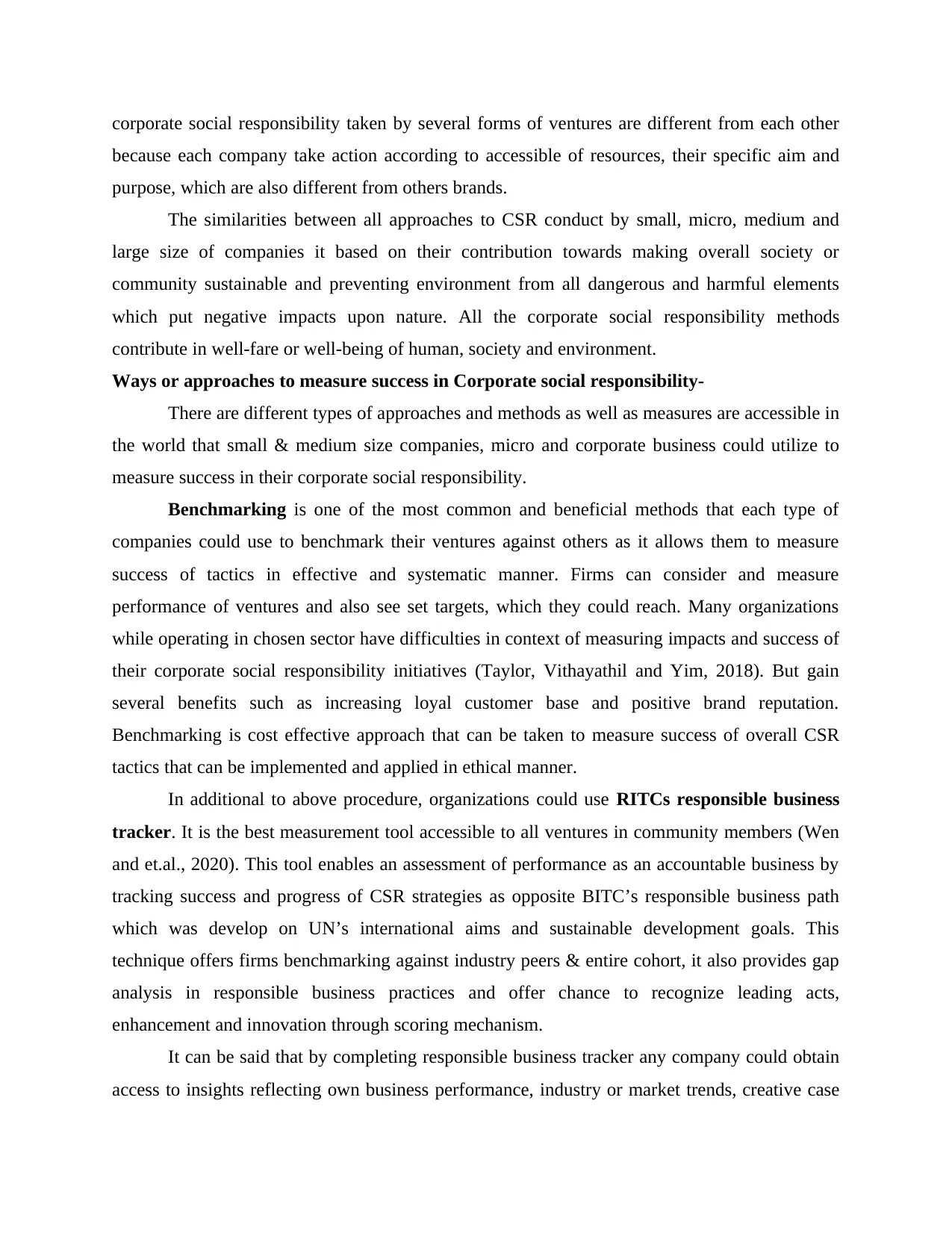
corporate social responsibility taken by several forms of ventures are different from each other
because each company take action according to accessible of resources, their specific aim and
purpose, which are also different from others brands.
The similarities between all approaches to CSR conduct by small, micro, medium and
large size of companies it based on their contribution towards making overall society or
community sustainable and preventing environment from all dangerous and harmful elements
which put negative impacts upon nature. All the corporate social responsibility methods
contribute in well-fare or well-being of human, society and environment.
Ways or approaches to measure success in Corporate social responsibility-
There are different types of approaches and methods as well as measures are accessible in
the world that small & medium size companies, micro and corporate business could utilize to
measure success in their corporate social responsibility.
Benchmarking is one of the most common and beneficial methods that each type of
companies could use to benchmark their ventures against others as it allows them to measure
success of tactics in effective and systematic manner. Firms can consider and measure
performance of ventures and also see set targets, which they could reach. Many organizations
while operating in chosen sector have difficulties in context of measuring impacts and success of
their corporate social responsibility initiatives (Taylor, Vithayathil and Yim, 2018). But gain
several benefits such as increasing loyal customer base and positive brand reputation.
Benchmarking is cost effective approach that can be taken to measure success of overall CSR
tactics that can be implemented and applied in ethical manner.
In additional to above procedure, organizations could use RITCs responsible business
tracker. It is the best measurement tool accessible to all ventures in community members (Wen
and et.al., 2020). This tool enables an assessment of performance as an accountable business by
tracking success and progress of CSR strategies as opposite BITC’s responsible business path
which was develop on UN’s international aims and sustainable development goals. This
technique offers firms benchmarking against industry peers & entire cohort, it also provides gap
analysis in responsible business practices and offer chance to recognize leading acts,
enhancement and innovation through scoring mechanism.
It can be said that by completing responsible business tracker any company could obtain
access to insights reflecting own business performance, industry or market trends, creative case
because each company take action according to accessible of resources, their specific aim and
purpose, which are also different from others brands.
The similarities between all approaches to CSR conduct by small, micro, medium and
large size of companies it based on their contribution towards making overall society or
community sustainable and preventing environment from all dangerous and harmful elements
which put negative impacts upon nature. All the corporate social responsibility methods
contribute in well-fare or well-being of human, society and environment.
Ways or approaches to measure success in Corporate social responsibility-
There are different types of approaches and methods as well as measures are accessible in
the world that small & medium size companies, micro and corporate business could utilize to
measure success in their corporate social responsibility.
Benchmarking is one of the most common and beneficial methods that each type of
companies could use to benchmark their ventures against others as it allows them to measure
success of tactics in effective and systematic manner. Firms can consider and measure
performance of ventures and also see set targets, which they could reach. Many organizations
while operating in chosen sector have difficulties in context of measuring impacts and success of
their corporate social responsibility initiatives (Taylor, Vithayathil and Yim, 2018). But gain
several benefits such as increasing loyal customer base and positive brand reputation.
Benchmarking is cost effective approach that can be taken to measure success of overall CSR
tactics that can be implemented and applied in ethical manner.
In additional to above procedure, organizations could use RITCs responsible business
tracker. It is the best measurement tool accessible to all ventures in community members (Wen
and et.al., 2020). This tool enables an assessment of performance as an accountable business by
tracking success and progress of CSR strategies as opposite BITC’s responsible business path
which was develop on UN’s international aims and sustainable development goals. This
technique offers firms benchmarking against industry peers & entire cohort, it also provides gap
analysis in responsible business practices and offer chance to recognize leading acts,
enhancement and innovation through scoring mechanism.
It can be said that by completing responsible business tracker any company could obtain
access to insights reflecting own business performance, industry or market trends, creative case
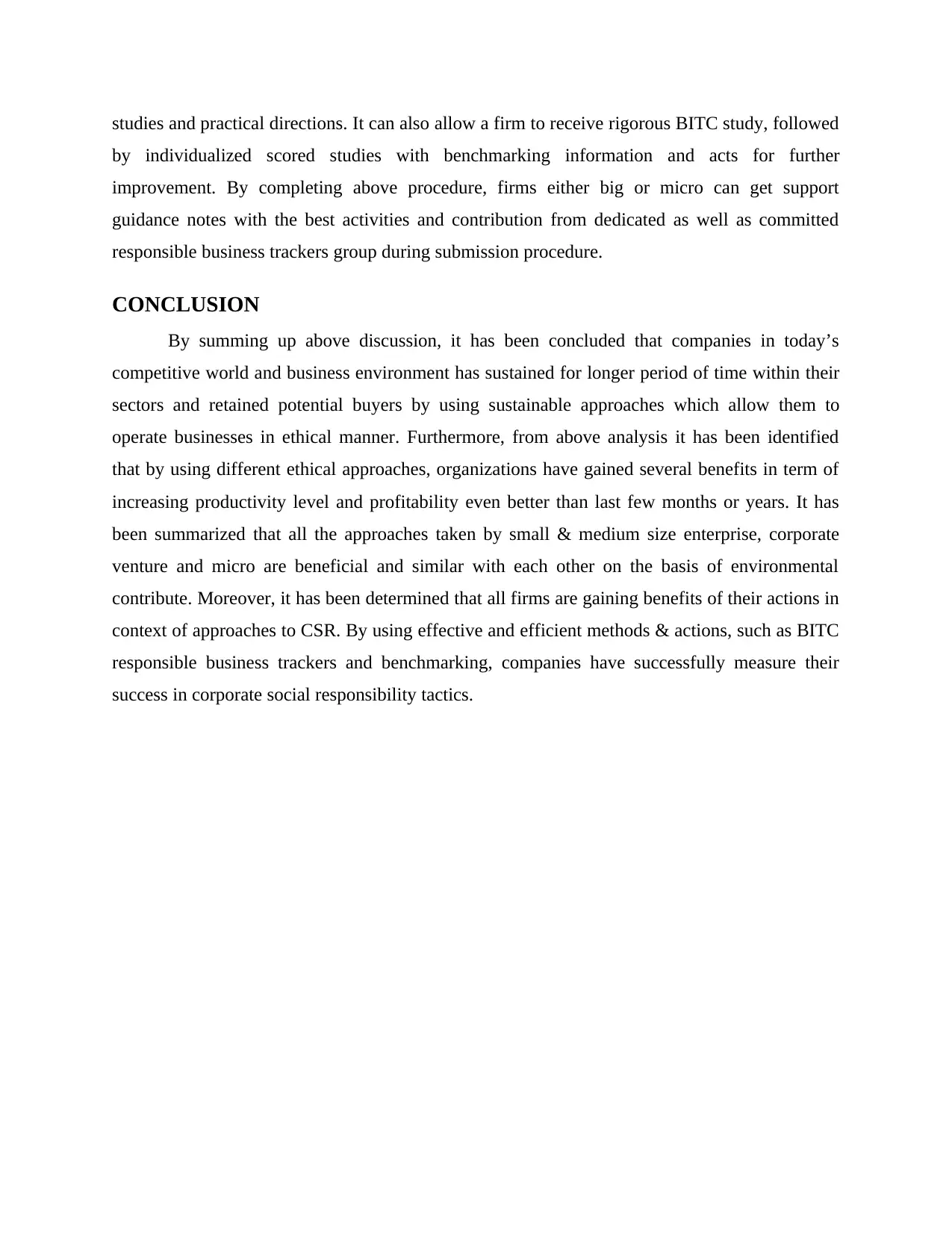
studies and practical directions. It can also allow a firm to receive rigorous BITC study, followed
by individualized scored studies with benchmarking information and acts for further
improvement. By completing above procedure, firms either big or micro can get support
guidance notes with the best activities and contribution from dedicated as well as committed
responsible business trackers group during submission procedure.
CONCLUSION
By summing up above discussion, it has been concluded that companies in today’s
competitive world and business environment has sustained for longer period of time within their
sectors and retained potential buyers by using sustainable approaches which allow them to
operate businesses in ethical manner. Furthermore, from above analysis it has been identified
that by using different ethical approaches, organizations have gained several benefits in term of
increasing productivity level and profitability even better than last few months or years. It has
been summarized that all the approaches taken by small & medium size enterprise, corporate
venture and micro are beneficial and similar with each other on the basis of environmental
contribute. Moreover, it has been determined that all firms are gaining benefits of their actions in
context of approaches to CSR. By using effective and efficient methods & actions, such as BITC
responsible business trackers and benchmarking, companies have successfully measure their
success in corporate social responsibility tactics.
by individualized scored studies with benchmarking information and acts for further
improvement. By completing above procedure, firms either big or micro can get support
guidance notes with the best activities and contribution from dedicated as well as committed
responsible business trackers group during submission procedure.
CONCLUSION
By summing up above discussion, it has been concluded that companies in today’s
competitive world and business environment has sustained for longer period of time within their
sectors and retained potential buyers by using sustainable approaches which allow them to
operate businesses in ethical manner. Furthermore, from above analysis it has been identified
that by using different ethical approaches, organizations have gained several benefits in term of
increasing productivity level and profitability even better than last few months or years. It has
been summarized that all the approaches taken by small & medium size enterprise, corporate
venture and micro are beneficial and similar with each other on the basis of environmental
contribute. Moreover, it has been determined that all firms are gaining benefits of their actions in
context of approaches to CSR. By using effective and efficient methods & actions, such as BITC
responsible business trackers and benchmarking, companies have successfully measure their
success in corporate social responsibility tactics.
⊘ This is a preview!⊘
Do you want full access?
Subscribe today to unlock all pages.

Trusted by 1+ million students worldwide
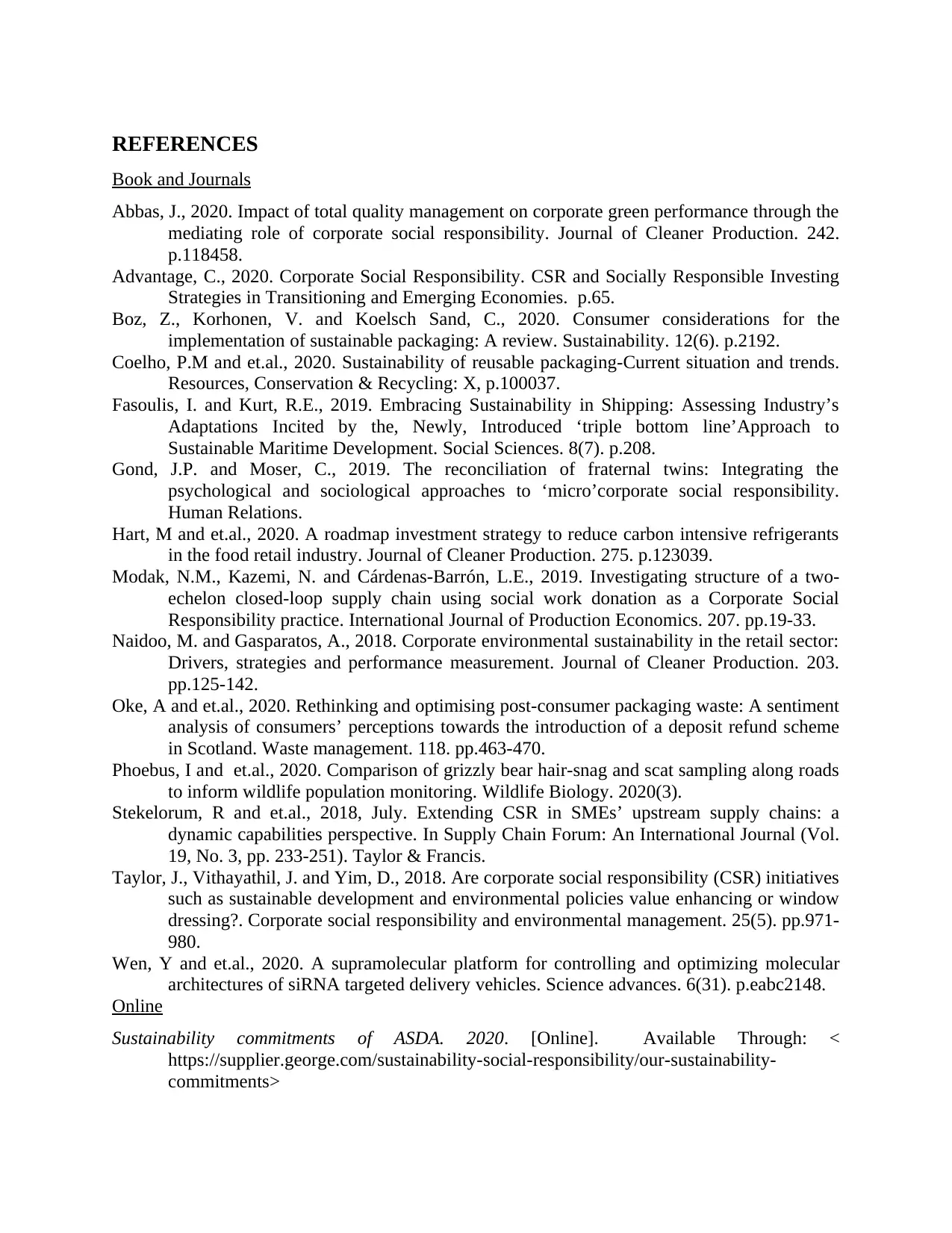
REFERENCES
Book and Journals
Abbas, J., 2020. Impact of total quality management on corporate green performance through the
mediating role of corporate social responsibility. Journal of Cleaner Production. 242.
p.118458.
Advantage, C., 2020. Corporate Social Responsibility. CSR and Socially Responsible Investing
Strategies in Transitioning and Emerging Economies. p.65.
Boz, Z., Korhonen, V. and Koelsch Sand, C., 2020. Consumer considerations for the
implementation of sustainable packaging: A review. Sustainability. 12(6). p.2192.
Coelho, P.M and et.al., 2020. Sustainability of reusable packaging-Current situation and trends.
Resources, Conservation & Recycling: X, p.100037.
Fasoulis, I. and Kurt, R.E., 2019. Embracing Sustainability in Shipping: Assessing Industry’s
Adaptations Incited by the, Newly, Introduced ‘triple bottom line’Approach to
Sustainable Maritime Development. Social Sciences. 8(7). p.208.
Gond, J.P. and Moser, C., 2019. The reconciliation of fraternal twins: Integrating the
psychological and sociological approaches to ‘micro’corporate social responsibility.
Human Relations.
Hart, M and et.al., 2020. A roadmap investment strategy to reduce carbon intensive refrigerants
in the food retail industry. Journal of Cleaner Production. 275. p.123039.
Modak, N.M., Kazemi, N. and Cárdenas-Barrón, L.E., 2019. Investigating structure of a two-
echelon closed-loop supply chain using social work donation as a Corporate Social
Responsibility practice. International Journal of Production Economics. 207. pp.19-33.
Naidoo, M. and Gasparatos, A., 2018. Corporate environmental sustainability in the retail sector:
Drivers, strategies and performance measurement. Journal of Cleaner Production. 203.
pp.125-142.
Oke, A and et.al., 2020. Rethinking and optimising post-consumer packaging waste: A sentiment
analysis of consumers’ perceptions towards the introduction of a deposit refund scheme
in Scotland. Waste management. 118. pp.463-470.
Phoebus, I and et.al., 2020. Comparison of grizzly bear hair-snag and scat sampling along roads
to inform wildlife population monitoring. Wildlife Biology. 2020(3).
Stekelorum, R and et.al., 2018, July. Extending CSR in SMEs’ upstream supply chains: a
dynamic capabilities perspective. In Supply Chain Forum: An International Journal (Vol.
19, No. 3, pp. 233-251). Taylor & Francis.
Taylor, J., Vithayathil, J. and Yim, D., 2018. Are corporate social responsibility (CSR) initiatives
such as sustainable development and environmental policies value enhancing or window
dressing?. Corporate social responsibility and environmental management. 25(5). pp.971-
980.
Wen, Y and et.al., 2020. A supramolecular platform for controlling and optimizing molecular
architectures of siRNA targeted delivery vehicles. Science advances. 6(31). p.eabc2148.
Online
Sustainability commitments of ASDA. 2020. [Online]. Available Through: <
https://supplier.george.com/sustainability-social-responsibility/our-sustainability-
commitments>
Book and Journals
Abbas, J., 2020. Impact of total quality management on corporate green performance through the
mediating role of corporate social responsibility. Journal of Cleaner Production. 242.
p.118458.
Advantage, C., 2020. Corporate Social Responsibility. CSR and Socially Responsible Investing
Strategies in Transitioning and Emerging Economies. p.65.
Boz, Z., Korhonen, V. and Koelsch Sand, C., 2020. Consumer considerations for the
implementation of sustainable packaging: A review. Sustainability. 12(6). p.2192.
Coelho, P.M and et.al., 2020. Sustainability of reusable packaging-Current situation and trends.
Resources, Conservation & Recycling: X, p.100037.
Fasoulis, I. and Kurt, R.E., 2019. Embracing Sustainability in Shipping: Assessing Industry’s
Adaptations Incited by the, Newly, Introduced ‘triple bottom line’Approach to
Sustainable Maritime Development. Social Sciences. 8(7). p.208.
Gond, J.P. and Moser, C., 2019. The reconciliation of fraternal twins: Integrating the
psychological and sociological approaches to ‘micro’corporate social responsibility.
Human Relations.
Hart, M and et.al., 2020. A roadmap investment strategy to reduce carbon intensive refrigerants
in the food retail industry. Journal of Cleaner Production. 275. p.123039.
Modak, N.M., Kazemi, N. and Cárdenas-Barrón, L.E., 2019. Investigating structure of a two-
echelon closed-loop supply chain using social work donation as a Corporate Social
Responsibility practice. International Journal of Production Economics. 207. pp.19-33.
Naidoo, M. and Gasparatos, A., 2018. Corporate environmental sustainability in the retail sector:
Drivers, strategies and performance measurement. Journal of Cleaner Production. 203.
pp.125-142.
Oke, A and et.al., 2020. Rethinking and optimising post-consumer packaging waste: A sentiment
analysis of consumers’ perceptions towards the introduction of a deposit refund scheme
in Scotland. Waste management. 118. pp.463-470.
Phoebus, I and et.al., 2020. Comparison of grizzly bear hair-snag and scat sampling along roads
to inform wildlife population monitoring. Wildlife Biology. 2020(3).
Stekelorum, R and et.al., 2018, July. Extending CSR in SMEs’ upstream supply chains: a
dynamic capabilities perspective. In Supply Chain Forum: An International Journal (Vol.
19, No. 3, pp. 233-251). Taylor & Francis.
Taylor, J., Vithayathil, J. and Yim, D., 2018. Are corporate social responsibility (CSR) initiatives
such as sustainable development and environmental policies value enhancing or window
dressing?. Corporate social responsibility and environmental management. 25(5). pp.971-
980.
Wen, Y and et.al., 2020. A supramolecular platform for controlling and optimizing molecular
architectures of siRNA targeted delivery vehicles. Science advances. 6(31). p.eabc2148.
Online
Sustainability commitments of ASDA. 2020. [Online]. Available Through: <
https://supplier.george.com/sustainability-social-responsibility/our-sustainability-
commitments>
Paraphrase This Document
Need a fresh take? Get an instant paraphrase of this document with our AI Paraphraser

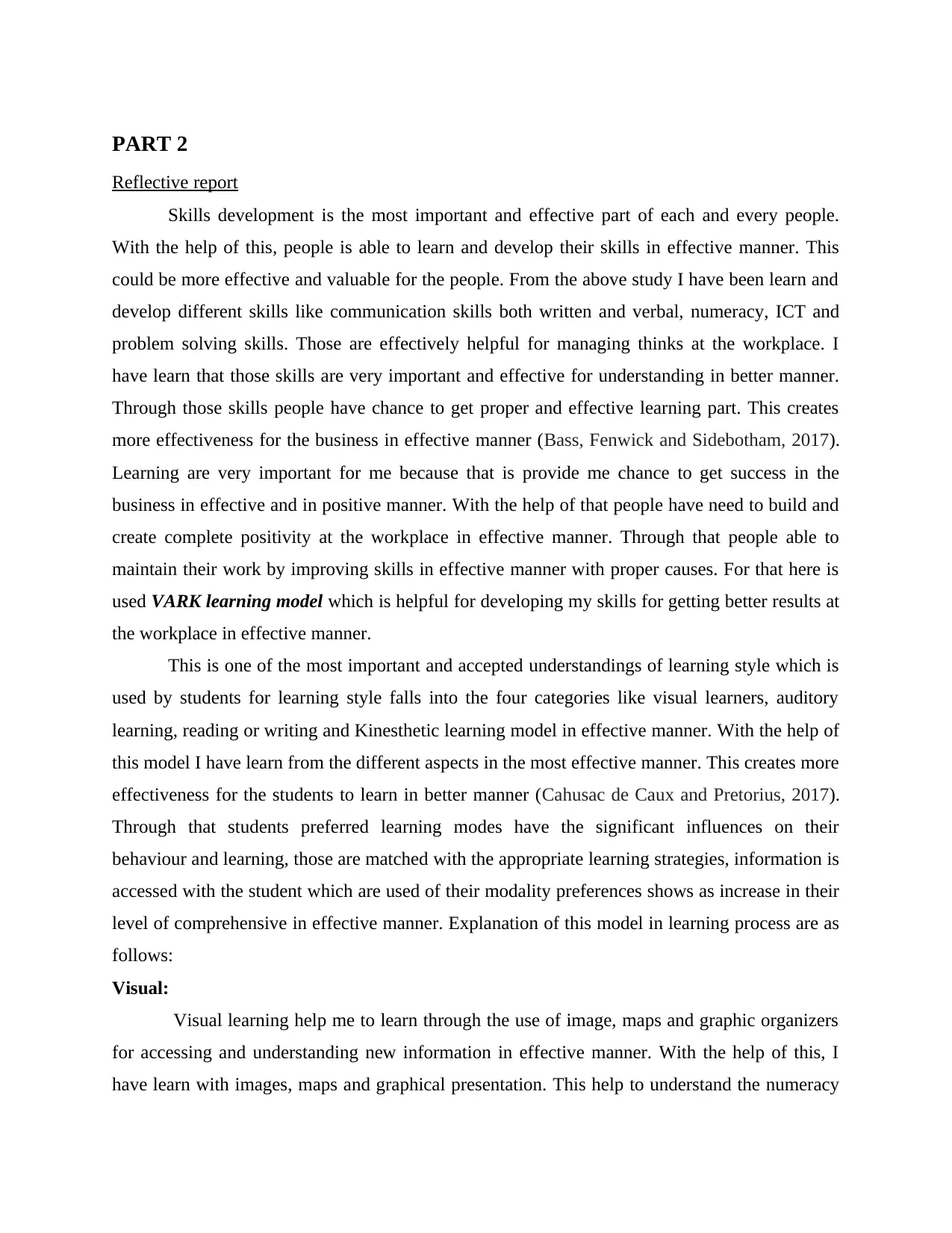
PART 2
Reflective report
Skills development is the most important and effective part of each and every people.
With the help of this, people is able to learn and develop their skills in effective manner. This
could be more effective and valuable for the people. From the above study I have been learn and
develop different skills like communication skills both written and verbal, numeracy, ICT and
problem solving skills. Those are effectively helpful for managing thinks at the workplace. I
have learn that those skills are very important and effective for understanding in better manner.
Through those skills people have chance to get proper and effective learning part. This creates
more effectiveness for the business in effective manner (Bass, Fenwick and Sidebotham, 2017).
Learning are very important for me because that is provide me chance to get success in the
business in effective and in positive manner. With the help of that people have need to build and
create complete positivity at the workplace in effective manner. Through that people able to
maintain their work by improving skills in effective manner with proper causes. For that here is
used VARK learning model which is helpful for developing my skills for getting better results at
the workplace in effective manner.
This is one of the most important and accepted understandings of learning style which is
used by students for learning style falls into the four categories like visual learners, auditory
learning, reading or writing and Kinesthetic learning model in effective manner. With the help of
this model I have learn from the different aspects in the most effective manner. This creates more
effectiveness for the students to learn in better manner (Cahusac de Caux and Pretorius, 2017).
Through that students preferred learning modes have the significant influences on their
behaviour and learning, those are matched with the appropriate learning strategies, information is
accessed with the student which are used of their modality preferences shows as increase in their
level of comprehensive in effective manner. Explanation of this model in learning process are as
follows:
Visual:
Visual learning help me to learn through the use of image, maps and graphic organizers
for accessing and understanding new information in effective manner. With the help of this, I
have learn with images, maps and graphical presentation. This help to understand the numeracy
Reflective report
Skills development is the most important and effective part of each and every people.
With the help of this, people is able to learn and develop their skills in effective manner. This
could be more effective and valuable for the people. From the above study I have been learn and
develop different skills like communication skills both written and verbal, numeracy, ICT and
problem solving skills. Those are effectively helpful for managing thinks at the workplace. I
have learn that those skills are very important and effective for understanding in better manner.
Through those skills people have chance to get proper and effective learning part. This creates
more effectiveness for the business in effective manner (Bass, Fenwick and Sidebotham, 2017).
Learning are very important for me because that is provide me chance to get success in the
business in effective and in positive manner. With the help of that people have need to build and
create complete positivity at the workplace in effective manner. Through that people able to
maintain their work by improving skills in effective manner with proper causes. For that here is
used VARK learning model which is helpful for developing my skills for getting better results at
the workplace in effective manner.
This is one of the most important and accepted understandings of learning style which is
used by students for learning style falls into the four categories like visual learners, auditory
learning, reading or writing and Kinesthetic learning model in effective manner. With the help of
this model I have learn from the different aspects in the most effective manner. This creates more
effectiveness for the students to learn in better manner (Cahusac de Caux and Pretorius, 2017).
Through that students preferred learning modes have the significant influences on their
behaviour and learning, those are matched with the appropriate learning strategies, information is
accessed with the student which are used of their modality preferences shows as increase in their
level of comprehensive in effective manner. Explanation of this model in learning process are as
follows:
Visual:
Visual learning help me to learn through the use of image, maps and graphic organizers
for accessing and understanding new information in effective manner. With the help of this, I
have learn with images, maps and graphical presentation. This help to understand the numeracy
⊘ This is a preview!⊘
Do you want full access?
Subscribe today to unlock all pages.

Trusted by 1+ million students worldwide
1 out of 15
Related Documents
Your All-in-One AI-Powered Toolkit for Academic Success.
+13062052269
info@desklib.com
Available 24*7 on WhatsApp / Email
![[object Object]](/_next/static/media/star-bottom.7253800d.svg)
Unlock your academic potential
Copyright © 2020–2025 A2Z Services. All Rights Reserved. Developed and managed by ZUCOL.





